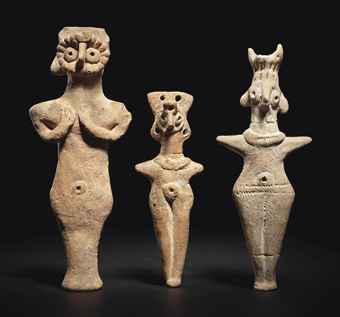Whether you know it or not you’re an idol. Many people have role models and they call these people idols. At the moment the world is watching the greatest athletes competing in the Olympics. Many of these athletes are ‘idolized’ in their home countries. This year American television audiences are gearing up for the tenth anniversary of the hit show American Idol where new stars are born. Many of us have role models and idols. When I was younger my idol was Jim Carey—true story. But this is not the kind of idol I’m referring to.
Throughout the Bible, particularly in the Old Testament, idolatry is condemned as a breach of the covenant. In fact, commandments one and two from the 10 commandments are both directed against idolatry. There is only one God and you should not construct any image to depict him. Idolatry is a term that has expanded a bit in Christian usage to include more than just the construction of images to depict the divine. In the introduction to A. W. Tozer’s Knowledge of the Holy idolatry is described as the entertainment of any thought about God that is unworthy of him. Likewise, in Timothy Keller’s Counterfeit Gods he describes the human heart as an idol making factory. Even covetousness is described as idolatry by the Apostle Paul (Col 3.5). False beliefs about God and passions for things that exceed one’s love for God certainly constitutes forms of idolatry. But my focus in this post is on the idolatry polemic against the physical construction of idols. Specifically I want to ask: why would God himself not want to be depicted by images?
The first thing to note is that the Old Testament paints a polemical picture of idolatry. That is to say, it does not attempt to describe an accurate portrayal of pagan worship. It is being polemical. So pagans didn’t actually worship the little statue they made. The statue was designed to mediate the presence of the divine. In the Ancient Near Eastern world the idol takes on this role of mediating divine presence through a ritual known as the “mouth opening ceremony” (mis pi). The name of the ritual itself resembles that of a midwife washing the mouth of a newborn child to depict the process of the statue’s birth [1]. Some scholars have described the ritual as having a ‘Eucharistic’ analogy to transubstantiation [2].
This understanding of how idols were properly used within pagan worship sheds light on a few OT passages, especially Isaiah 6. For many this is a familiar passage. Isaiah receives a vision of the Lord and realizes that he is impure. In the center of the temple Isaiah sees the Lord seated on a throne with angelic beings ceaselessly declaring the holiness of God. In this setting an angel cleanses Isaiah’s lips and declares him clean. It is quite likely that this scene is an enacted dramatization of the well-known “mouth opening ceremony.” This is particularly relevant since the vision takes place within the temple (Isa 6:1) and the vision concludes with an idolatry-related judgment upon Israel. Because of Israel’s idolatry (Isa 2.18, 20), Israel will be made as obtuse as the idols she worships (Isa 6.9-10). As G. K. Beale has wonderfully demonstrated, one of the major anti-idolatry polemics in the OT is that you become what you worship (cf. Ps 115.4-8; 135.15-18). In this context then, Isaiah is being made into the true ‘idol of God’ as a polemic against the foreign idols of Israel [3]. In fact, this coheres with the original intentions that God had for humanity. When God created Adam he ‘breathed into his nostrils’ and he became a living creature (Gen 2.7). Thus, when God breathed into Adam he was consecrating him as the true idol within the temple of his creation. Adam was intended to represent God in a manner analogous to idols within pagan worship.
So in response to my original question — why would God himself not want to be depicted by images? — the answer is that God’s original intention for humanity was that humans would constitute the physical representation of God. Idols are not to be used in worship because they remove the role and function of humans in this regard. Humans are the true idols of God. There is a deep sense of calling and purpose associated with this, especially as it relates to missions and evangelism. As an idol you will either be used to point to God or elsewhere. In the Ancient Near Eastern world idols were not designed to point to themselves. True idols do not exhaust anything. They are not ends. True idols are windows to God’s throne room. Be the idol you were made to be.
[1] Christopher Walker and Michael B. Dick, “The Induction of the Cult Image in Ancient Mesopotamia: The Mesopotamian mis pi Ritual,” in Born in Heaven, Made on Earth: The Making of the Cult Image in the Ancient Near East, ed. Michael B. Dick (Winona Lake, IN: Eisenbrauns, 1999), 68.
[2] See e.g. Michael B. Dick, “Mesopotamian Cult Statue: A Sacramental Encounter with the Divine,” in Cult Image and Divine Representation in the Ancient Near East, ed. Neal H. Walls (Boston: American Schools of Oriental Research, 2005), 51-52.
[3] So Edward Curtis, “The Image of God (OT),” The Anchor Bible Dictionary, vol 3 (New York: Doubleday, 1992), 390. For humanity as cultic images in anti-idolatry polemic see Crispin H. T. Fletcher-Louis, “God’s Image, His Cosmic Temple and the High Priest,” in Heaven on Earth: The Temple in Biblical Theology, ed. T. Desmond Alexander and Simon Gathercole (Waynesboro, GA: Paternoster, 2004), 83.





3 Comments
Leave your reply.